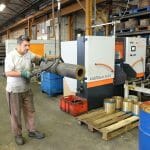Thousands of pharmaceutical manufacturers and packers across the EU face the rather costly prospect of re-engineering their production lines to satisfy the EU Falsified Medicines Directive (FMD). Systems that carry out coding and inspection offline could be one way of easing the compliance burden.
The Falsified Medicines Directive (FMD), aimed at reducing the number of falsified and counterfeit medicines infiltrating the legal pharmaceutical supply chain within Europe, was implemented in 2011. From January 2016 onwards manufacturers failing to comply with the directive will have to withdraw their products from the European market.
A core requirement of the legislation is the serialisation of individual pharmaceutical packs, via unique codes encrypted in machine readable 2D datamatrix codes. Besides a randomised unique serial number, the datamatrix codes will be required to carry a manufacturer product code, expiry date and batch number. This increases the burden on pharmaceutical manufacturers when it comes to coding cartons, as they have to print and verify complex datamatrix codes at high speeds, which is both costly and complex to do.
The majority of manufacturers will have to upgrade their production lines to accommodate sophisticated coding and image recognition systems that are capable of working at high speeds. And it’s not just old embossing kit and hot foil coders that will have to go. According to some estimates, up to 80% of the coding solutions currently used in pharmaceuticals and healthcare will be rendered obsolete by FMD.
Retrofitting a coding station that can transport the filled carton, print and inspect the code and reject problem packs is problematic on lines where space is at a premium, introduces the challenge of integrating different interfaces and can compromise line efficiency.
CIJs fall short
Whilst in theory most modern inline coders are capable of reliably producing readable 2D codes, in reality, this is not always the case. Manufacturers are typically finding that continuous ink jets (CIJs) are not up to the challenge, because they struggle to consistently produce 2D codes that meet the ISO/IEC 15415 quality specification.
Code quality is crucial for machine readable codes. Under the FMD, 2D codes must be verified via a camera-based system to confirm that the unique number encrypted in the code has been printed on the pack. Vision system performance is influenced by the quality of the code, and 2D codes that are slightly fuzzy, blurred or out-of-position might be unreadable. Rejection and rework of any packs carrying unreadable codes will have serious implications for overall equipment effectiveness (OEE).
There are other reasons against CIJ for pharmaceutical coding besides its relatively low print resolution. The technology is perceived as messy and dirty, with a high risk of ink spillage and odours emitted by the solvents used.
Thermal inkjet printers (TIJs) place their pixels more accurately and offer higher resolution printing (typically 300 dpi or above) than CIJ systems. This makes TIJ the obvious print technology of choice for pharmaceutical 2D codes.
Perfect presentation a must
However, even where manufacturers are using TIJ, print quality is still dependent on the presentation of the carton to the printer. Datamatrix barcoding requires near perfect presentation of a carton to the printer in order to achieve the highest verification grade. This means cartons must be fed smoothly, flat and square to the printer.
Any deviation from this may cause a serious flaw in the print, resulting in mis-coded packs that cannot be validated by an online vision system. Recurrent mis-codes can lead to major production inefficiencies.
To this end, accurate carton feeding is crucial, and with an online system, the necessary accuracy will rarely be achieved without the addition of an extra line element that controls the carton during print and inspection. This can have serious space implications and revalidation issues.
Pharmaceutical cartons are usually coded on the end flap. Further potential for mis-codes arises when the closed end flap bulges, presenting a convex surface to the printer.
Maintaining line speeds
Producing high quality serialised codes at the line speeds required by some pharmaceutical operations is no mean feat either. Current systems generally print the same information, say, 20,000 times. With serialisation you’re printing 20,000 batches of one at rates of up to eight per second. Manufacturers have to get all those numbers to the printer, filed, printed and never duplicated. The key is getting data into the printer and making sure print speed is high, so factors like drying time become very important.
The absolute requirement for codes to be verified immediately after printing may also impact line efficiency. Essentially, the vision system needs enough time to acquire an image of the 2D code and the human readable lines of text, to process that information and come back with a decision as to whether the pack is acceptable before the next pack is in front of the camera.
Both the printing of serialised codes and the code verification step could slow down the line.
Taking coding offline
For many pharmaceutical operations, the answer to these issues could lie in taking coding offline, with a modular system that incorporates printing, labelling, inspection and automatic stack-to-stack feeding technology.
Offline overprinting systems come into their own where a large amount of text is required or the print is required to meet an exacting standard, such as the 2D datamatrix code on a pharmaceutical carton. By taking this process offline, the cartons are brought to the line ready printed and inspected, eliminating any delays due to coding issues. The potential for rejects is massively reduced because the carton can be presented to the printer in the most favourable orientation. For example, an offline system will print cartons flat, so there are no problems with mis-codes on bulging end flaps.
Gravity also works in the favour of offline printing. Whereas an online printer usually sits adjacent to the line and applies the ink across the pack, on an offline system the nozzles fire the ink from above. This minimises the risk of run from excess ink and produces super-crisp codes.
Many companies assume that an online system will be faster and more efficient than an offline one, but once you take into account the impact that inline verification, serialised code printing and mis-codes could have on line efficiency and OEE, offline coding starts to look like an attractive option. Speeds of up to 200 packs per minute are well within the capabilities of an offline coder, and a range of pharmaceutical packaging formats can be coded offline, including cartons, wallets, sleeves and crash-lock cartons. In fact, small batches of only a few hundred cartons or even less than a hundred are more efficient and economical coded offline.
Systems can be positioned either near or next to a line to keep it supplied during running or can supply a second line in a central location.
Counting the cost of compliance
From an investment point of view, the cost of complying with FMD through an offline system is far lower than the cost of upgrading an online system, particularly when you take into account disruption and downtime. Based on experience, it can take several months to decide on your equipment supplier, then up to a year to set up and test a new line. An offline system is independent of the production line and can be up-and-running in a matter of weeks.
Offline coding might sound like a low tech solution, but this is not necessarily the case. Offline coders can be built with an inline diverter-flap reject system for automatic removal of reject cartons, software controls and shingling (accumulation) conveyors to maintain high throughput. Integral inspection of printed information and pharmacode verifies that datamatrix codes and human readable information such as expiry dates and lot codes are correct.
Offline systems can be fitted with either a thermal inkjet or a thermal transfer printer, depending on the application. In some scenarios, a system incorporating both technologies may be configured. For example, manufacturers may want thermal inkjet for printing on the flap of a carton, which is a rough, varnish free surface, and thermal transfer for coding the main body of the pack, which is a smooth, glossy surface.
It is not just small, low volume producers and packers who are embracing offline coding. Multi-national pharmaceutical manufacturers are increasingly realising that it offers a way of complying with the new legislation without impacting the production line.
Weigh up all options
The timetable for FMD implementation is tight, but instead of rushing into expensive upgrades to their production lines, pharmaceutical manufacturers and packers would be well advised to consider offline as well as online options. With the FMD, coding has become a core capability – without it you cannot manufacture – so there is no margin for error.








Leave a Reply